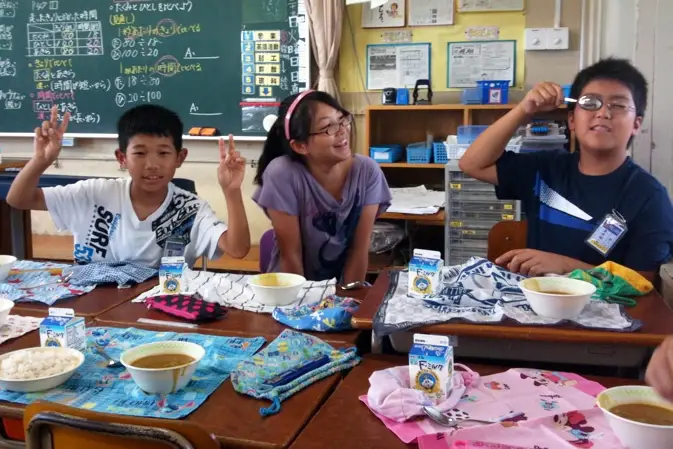A long, happy life starts with a healthy childhood, and there is one country that has everyone else beat when it comes to raising healthy children. In Japan, boys and girls are expected to live into their 80s and have virtually no major illnesses until the age of 73, according to a study from The Lancet.
Top 10 countries that the study found to follow Japan with the highest healthy life expectancy are Singapore, Andorra, Iceland, Cyprus, Israel, France, Italy, South Korea, and Canada. All these countries have a life expectancy of about 72 years old.
The U.S. ranked number 32 with a healthy life expectancy of 69, according to WHO.
For many Americans chronic illnesses start as early as childhood with many autoimmune disorders and emotional problems on the rise. And to make American children healthier, there is a lot to learn from the Japanese culture.
The Lancet study inspired Naomi Moriyama and William Doyle to analyze the traditional Japanese lifestyle and write a book titled “Secrets of the World’s Healthiest Children: Why Japanese Children Have the Longest, Healthiest Lives – And How Yours Can Too.”
“Compared with other developed nations, Japanese people on average eat fewer calories per day, and in a healthier pattern: more fish, more vegetable products, less meat and dairy, smaller desserts and more reasonable portion sizes,” Moriyama told Today.com
Here are just a few things they found that Japan does differently when it comes to raising healthy children.
1.Always Stock Your Kitchen with Healthy Food Options
Many American kitchens are full of the type of processed food-junk overflowing on supermarket shelves: sugary cereals, soda pop, and sweet snacks like Pop Tarts, and candy. Fortunately, this is slowly changing, especially in health-conscious families.
Many children and even adults eat with their eyes. It is a psychological phenomenon that is often abused by the food industry by adding bright toxic food dyes to many foods in order for it to look more appealing.
This is one of the reasons why it is important to stock your kitchen with bright fresh fruit and vegetables, as well as healthy cooked foods. If all the children see is healthy food, eventually they will become drawn to it naturally.
“This way if your child wants to open the cupboard and eat something they will be presented with healthy options. As they get older, they are exposed to things that you want them to eat,” Moriyama advises.
2. Do Not Restrict What Kids Eat in Snacks and Sweets, Instead Restrict How Much They Eat
Telling a child they cannot have something is in the end counterproductive. They will find a way to get it elsewhere, still from the cupboard or at school, and are more likely to eat it in excess. (the same goes with adults and diets!)
Moriyama recommends to never say “no” to any particular food, but instead practice moderate restraint. Eat anything, but in moderation.
She says, “For us, it’s really about having moderate restraint — meaning don’t demonize food. Food is to be enjoyed with your family and people you love. It’s OK to have treats once in a while, in moderation.”
3. Prepare Meals That Have Fewer ‘Calories Per Bite’
Japanese meals rarely use any processed foods, instead consisting of made-from-scratch items that are served at modest-portions in small plates. These plates can be of soup, rice, fish, meat, tofu, and vegetable sides. Vegetables, fruits, whole grains, and fish and lower in calorie density and are preferred food ingredients in the Japanese cuisine.
4. Japanese Kids Walk or Bike To School
They say movement is the key to a long life, and Japanese people start the health physical activity habit early. Instead of getting on a school bus, over 98% of Japanese kids walk or bike to school. While that option is rarely available in the U.S., it is important to find a way for the kids to go on daily walks or get another kind of exercise every day; 60 minutes a day is recommended.
“Here’s the easiest tip of all: Switch off your electronic devices for an hour at night, go out and take a brisk power-walk together with your family, no excuses,” Moriyama said. “The health benefits for children… are tremendous.”
5. Replace Breads and Noodles with Rice
Most Japanese meals come with plain fluffy rice, which is very filling. Many experts agree that brown rice is the best option.
There have been a few concerns with arsenic in rice in the recent years, but buying organic rice grown by a trustworthy company is generally a sound option.
6. Eating a Healthy Lunch at School is The Most Important
Japan is also making a huge difference in children’s health by providing healthy lunches at school that are made from scratch. Unhealthy options are generally not sold, and there are no vending machines.
Not only are kids eating healthy, but they are also taught how to cook and serve each other food; they are expected to help clean up after themselves, and some schools even have vegetable gardens, and the kids help grow the food used in the cafeteria.
Lunches consist of fish products, rice, and vegetables, with fruits and yogurt for dessert. There are rarely any fried items or sugary treats.
Many schools also have nutritionists on board that work with kids who are picky or unhealthy eaters.
“Japan’s standpoint is that school lunches are a part of education, not a break from it,” a school health director in Japan told Moriyama.
The result of this lunch program? Japan already has one of the lowest childhood obesity rates in the world, which has declined further in the last decade.
See how different American and Japanese school lunch programs are in the video report below:
Japan's school lunches put America to shame.Learn more about school lunches around the world here: attn.link/1SXSHnoLike ATTN: Video on Facebook.
Posted by ATTN: Video on Tuesday, April 19, 2016
Recommended reading:
7 Ways to Raise Kind Children, According to Harvard Research
This Barely Eaten Vegetable is the #1 Longevity Secret for Okinawans Living in the Blue Zone
Thanks for installing the Bottom of every post plugin by Corey Salzano. Contact me if you need custom WordPress plugins or website design.







